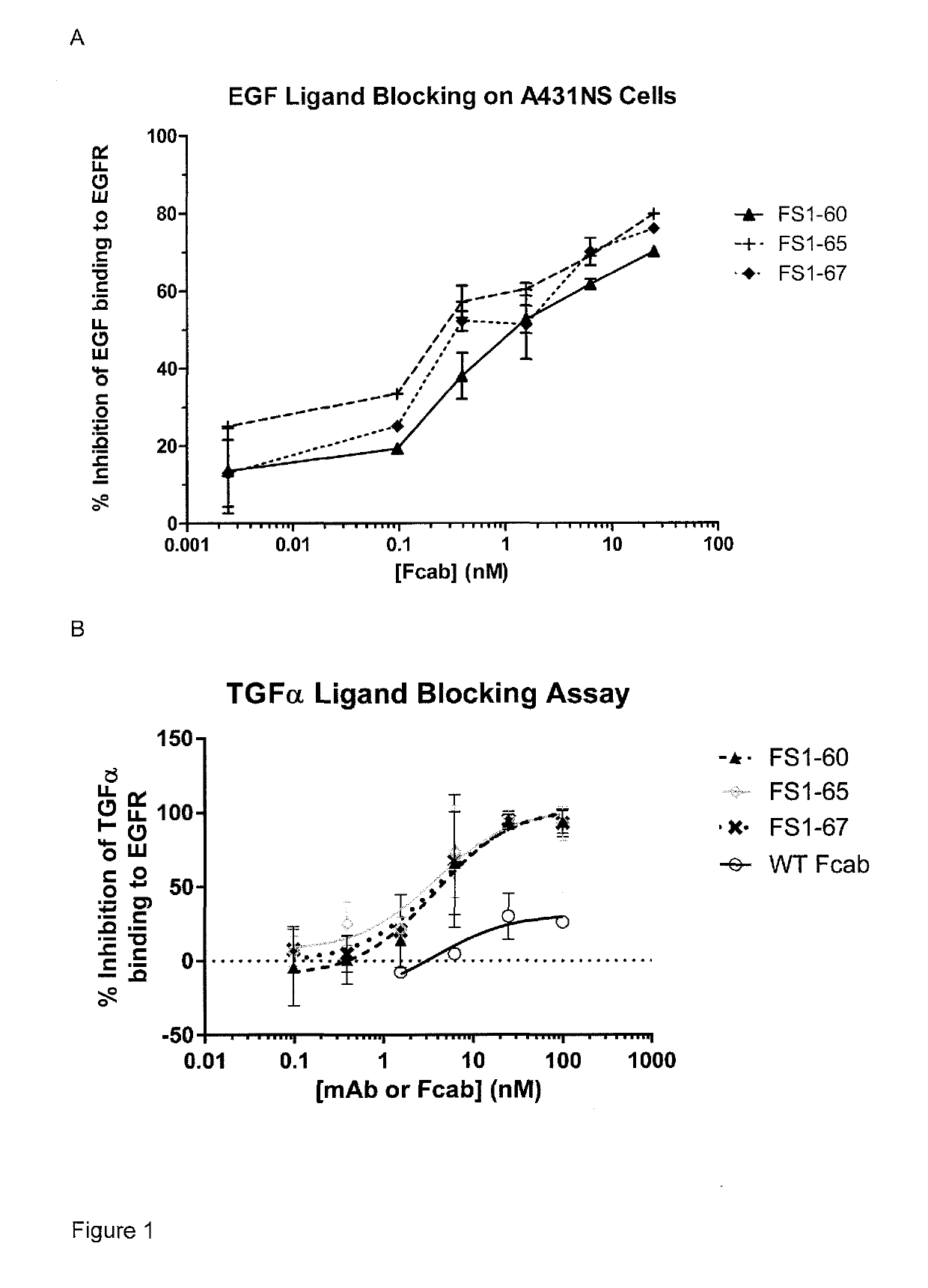EGFR binding molecules
a technology of egfr and binding molecules, which is applied in the field of specific binding members, can solve the problems of limited use of egfr-targeting single-agent therapies in the clinic, skin rash and lesions, etc., and achieves the effects of less skin toxicity, improved efficacy of egfr-targeting therapies, and potent anti-tumour effects
- Summary
- Abstract
- Description
- Claims
- Application Information
AI Technical Summary
Benefits of technology
Problems solved by technology
Method used
Image
Examples
example 1
on of Anti-EGFR Antigen-Binding Fcs (Fcabs)
[0148]EGFR specific Fcabs were selected by Fluorescence Activated Cell Sorting (FACS) from a yeast display Fcab library and by magnetic bead capture from a phage display Fcab library as described below.
[0149]Naïve Selection of Anti-EGFR Fcabs from a Yeast Library Using FACS
[0150]The method used to select antigen specific Fcabs from yeast display Fcab libraries by FACS is described in WO 2009 / 132876. Libraries expressing Fcab clones on the yeast cell surface were incubated with 300 nM of biotinylated EGFR extracellular domain. The cells were then stained with streptavidin-allophycocyanin (APC) (BD Bioscience, 349024) for isolation of antigen-binding yeast cells by fluorescent signal using a high speed cell sorter (BD Bioscience, FACSAria). This selection procedure was repeated several times to enrich for a sufficiently pure antigen-binding yeast cell population. Streptavidin-APC and anti-Biotin-APC (Miltenyi Biotec, 130-090-856) were used in...
example 2
ific Fcabs Bind Specifically to EGFR
[0157]An enzyme-linked immunosorbent assay (ELISA) was used to determine if the anti-EGFR Fcabs, FS1-60, FS1-65 and FS1-67 specifically bind to EGFR in the HER receptor family.
[0158]Antigens including EGFR (produced in house), HER2 His Tag (Sino Biological, 10004-H08H), HER3 His Tag (Sino Biological, 10201-H08H) and HER4 His Tag (Sino Biological, 10363-H08H) were biotinylated using the Lightning-Link™ Biotin kit (Innova Biosciences, 704-0030) following the supplier's protocol. The biotinylated antigens were coated in different wells on MaxiSorp plate (Nunc) at 1 μg / ml in PBS overnight at 4° C. and excess unbound antigens were washed off with PBS. The antigen-coated plate was blocked with 1% tween in PBS (PBST) for 1 hour at room temperature. After removing PBST, the anti-EGFR Fcabs (1 μM) and relevant positive and IgG negative antibody controls (1 μM) in 0.1% PBST were incubated for 1 hour to bind the coated antigens followed by washing. The bound...
example 3
ific Fcabs Bind to a Different Epitope on EGFR than Cetuximab
[0160]Surface Plasmon Resonance (SPR) was used to determine if the EGFR specific Fcabs FS1-60, FS1-65 and FS1-67 compete with the known anti-EGFR antibody, cetuximab (Merck), for binding to EGFR.
[0161]A BIAcore 3000 (GE healthcare) was used to determine if EGFR specific Fcabs FS1-60, FS1-65 and FS1-67 could bind to a human EGFR coated chip that was saturated with cetuximab (CX) and vice versa.
[0162]A streptavidin chip (SA chip) (GE Healthcare BR-1000-32) was coated with 200 RU of extracellular domain (ECD) of biotinylated human EGFR. Experiments were carried out using a flow rate of 20 μl / min in HBS-P buffer (GE Healthcare), and the EGFR surface was regenerated by flowing over 50 mM NaOH at 50 μl / min for 12 sec three times. The first EGFR binding compound (EGFR specific Fcabs or cetuximab) was injected at 20 μl / min for 4 min and then the second EGFR binding compound (cetuximab or EGFR specific Fcabs) was injected for 4 min...
PUM
| Property | Measurement | Unit |
|---|---|---|
| Fraction | aaaaa | aaaaa |
| Current | aaaaa | aaaaa |
| Molar density | aaaaa | aaaaa |
Abstract
Description
Claims
Application Information
 Login to View More
Login to View More - R&D
- Intellectual Property
- Life Sciences
- Materials
- Tech Scout
- Unparalleled Data Quality
- Higher Quality Content
- 60% Fewer Hallucinations
Browse by: Latest US Patents, China's latest patents, Technical Efficacy Thesaurus, Application Domain, Technology Topic, Popular Technical Reports.
© 2025 PatSnap. All rights reserved.Legal|Privacy policy|Modern Slavery Act Transparency Statement|Sitemap|About US| Contact US: help@patsnap.com



